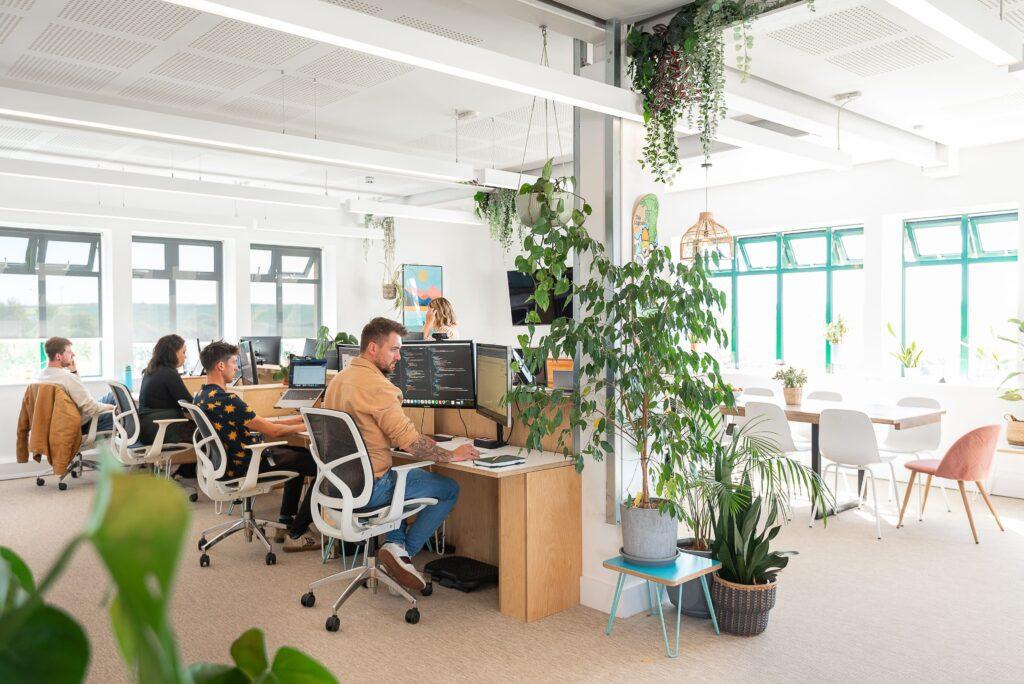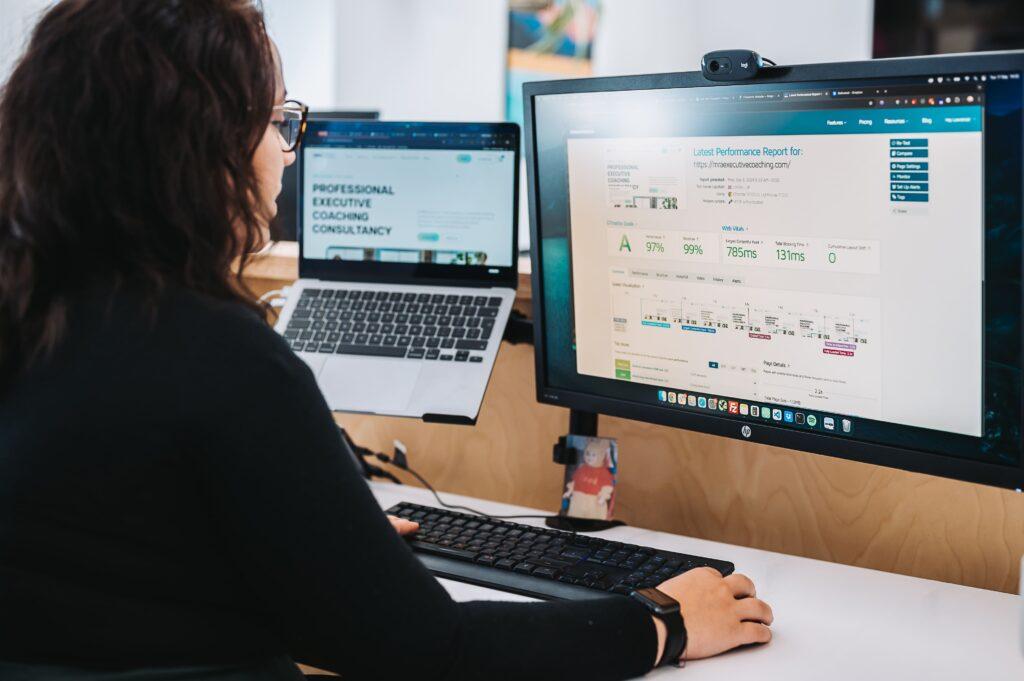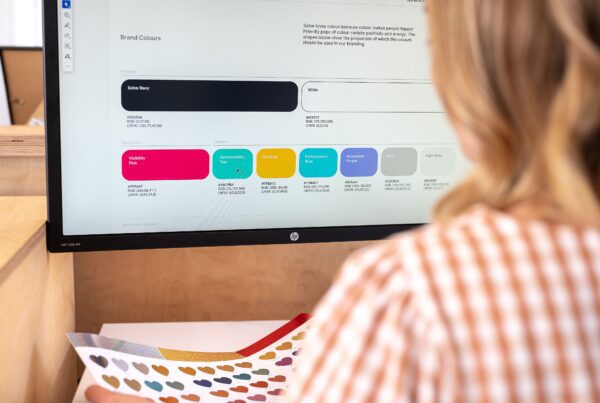
Table of Contents
Sustainable web design is about building websites that perform brilliantly while minimising their environmental impact. At Solve, this approach is central to what we do. As a certified B Corp and green hosting provider, we combine low-impact design with 100% renewable-powered hosting to create websites that are fast, functional, and low-impact.
So how can sustainable web design benefit both your business and the planet? Let’s explore the key advantages.
What Is Sustainable Web Design?
Sustainable Website Design Defined
Sustainable web design is about creating websites that run efficiently over the long term, reducing energy use and environmental impact. It goes beyond surface-level aesthetics or short-term fixes by considering the full life cycle of a site, from hosting and build to maintenance and everyday use.
A more sustainable website uses fewer resources, loads quickly, and lasts longer without constant overhauls. In short, it’s about designing digital experiences that are both functional and beautiful, while staying mindful of their impact on the planet.
Why It Matters in Today’s Digital World
The internet may feel weightless, but it’s actually energy-heavy. Every search, download, and video stream depends on data centres, servers, and networks powered by electricity. Research shows that digital technologies account for around 3–4% of global greenhouse gas emissions, and that figure is rising by roughly 9% each year.
Businesses have a responsibility to reduce their digital footprint, and sustainable web design is a powerful way to do so. It can also cut costs and strengthen connections with customers who value eco-conscious brands.
Environmental Impact of Traditional Web Design
Traditional websites were often built with little thought for their environmental impact. Oversized images, autoplay videos, and poorly optimised code all demand unnecessary data and energy. While these choices may seem harmless, across thousands of visits they add up to significant emissions.

8 Key Benefits of Sustainable Web Design
So how can sustainable web design make a difference for both people and the planet? Let’s explore the key benefits.
1. Reduced Carbon Footprint
The most obvious benefit of sustainable web design is reducing your company’s carbon footprint. By streamlining design, optimising images, and using green hosting, you can reduce your energy consumption, lowering associated carbon emissions and helping you make genuine progress toward sustainability targets.
2. Faster Website Performance
Energy-efficient, lean websites load faster. By removing unnecessary scripts, compressing media, and focusing on efficiency, sustainable websites deliver lightning-quick performance. Faster load times not only improve user satisfaction but also directly impact sales, conversions, and even SEO. In fact, studies show that a website that loads in one second has a three times higher conversion rate than a site that takes five seconds.
3. Lower Hosting Costs
Every file stored and every request processed requires server resources. A lighter, more efficient website uses less storage and bandwidth, often resulting in lower hosting fees. For businesses running large-scale platforms or e-commerce sites, these savings can add up significantly over time.

4. Stronger Brand Reputation
Sustainability is a powerful differentiator. Consumers are increasingly looking for eco-conscious brands, and your website is one of your most visible assets. A business that actively pursues eco-friendly web design demonstrates values in action, signalling responsibility, transparency, and a care for our planet’s future.
Sharing these efforts openly, like highlighting your choice of green hosting or commitment to efficient design, can enhance your brand’s reputation and foster long-term customer loyalty. Here at Solve, many of our clients proudly display their ‘powered by green hosting’ badge on their website.
5. Improved Search Engine Optimisation (SEO)
Google rewards fast, efficient websites. Page load speed and mobile optimisation are critical ranking factors, and sustainable web design naturally improves both. By minimising scripts, reducing file sizes, and structuring clean code, websites perform better in search engines, meaning more organic traffic and better visibility in search.
6. Better User Experience (UX)
Few things are more frustrating than a slow website that makes it hard to find what you need. Sustainability and usability go hand in hand: a clean, well-structured site is easier to navigate, quicker to load, and accessible across all devices. This enhances satisfaction and reduces bounce rates, creating a better overall experience. Streamlining user journeys is part of this process, and simplifying site architecture reduces the number of clicks needed to find information, saving time, energy, and above all, frustration.
7. Long-Term Cost Efficiency
Flashy websites with heavy features often require constant fixes and redesigns. Sustainable websites are built with longevity in mind. Efficient code, scalable infrastructure, and clear content strategies reduce the need for frequent redevelopment, cutting maintenance resources over time.
8. Competitive Advantage in a Green Market
Sustainability has become a key market differentiator. Businesses that adopt eco-friendly practices early gain an edge over competitors that lag behind. As regulations tighten and customer expectations rise, companies that demonstrate sustainable principles throughout their operations will already be positioned as leaders.
This advantage goes beyond marketing. Strong sustainability credentials can also help secure partnerships, funding, and procurement opportunities where responsibility is a deciding factor.

Sustainable Web Design Best Practices
Optimise Images and Media Files
Media files are often the biggest contributor to website weight, making optimisation one of the simplest and most effective steps toward a more sustainable site. Using lightweight visuals such as SVGs and illustrations, compressing images without losing quality, and enabling lazy loading all help reduce data transfer. Hosting large videos externally, on platforms like YouTube, also helps lighten the load. Taken together, these steps ensure pages load quickly without sacrificing visual impact.
Choose Green Web Hosting Providers
Hosting accounts for a large share of your website’s energy consumption, so choosing a provider powered by renewables is an effective way to cut emissions. At Solve, we don’t just design sustainable websites; we’re a certified B Corp and proud green web hosting provider. And we’ll even plant trees on your behalf when you sign up to one of our green hosting plans.
Limit Energy-Intensive Features
Features like auto-playing videos, complex animations, and unnecessary plug-ins may impress visually, but they also drain energy and slow down performance. By focusing only on features that genuinely add value and support business goals, you can create a lighter, faster, and more user-friendly website. And stripping away the unnecessary improves both efficiency and sustainability – win-win.
Write Efficient Code and Use Fewer Scripts
Efficient code is fundamental in sustainable web design. Bloated or outdated code creates extra server requests, slowing sites down and wasting energy. Writing clean, well-structured code, limiting third-party scripts, and regularly auditing plug-ins keep websites lean and reliable.
Lightweight frameworks add another layer of efficiency, making sites easier to maintain, faster to run, and less resource-intensive. The same principle applies to design systems. Clean layouts, limited fonts, and reusable components all help create websites that perform better and use fewer resources.
Creating Environmentally Friendly Website Content
Here are some simple but effective ways to keep your website content as environmentally friendly as possible.
Keep Content Relevant and Purpose-Driven
Unnecessary or outdated content takes up storage and clutters the user experience. Every blog post, product description, or landing page should serve a clear purpose. Regular content audits help remove pages that no longer add value, keeping your website lean and making it easier for visitors to find what they need.
Prioritise Readability and Accessibility
By making content accessible, easy to read and navigate, you reduce the time and energy users spend searching for information.
Key tips include:
- Use clear headings and short paragraphs.
- Choose legible fonts with sufficient contrast.
- Structure pages for scanning with bullet points and subheadings.
- Add alt text to images for screen readers.
Improving the accessibility of your site also enhances SEO and overall user satisfaction.
Use Dark Mode or Low-Energy Colour Schemes
Dark mode can reduce power use on OLED screens, while flat, low-energy colour palettes help lower consumption and ease visual strain. The trade-off is largely aesthetic; brighter colour schemes typically demand more power, so it becomes a brand decision to weigh up. With thoughtful choices, businesses can balance sustainability with a visual style that still feels modern and engaging.
Real Examples of Sustainable Web Design in Action
Brands Leading the Way in Eco-Friendly Design
At Solve, we use our own IO framework to guide every project. It brings together five key elements – digital sustainability, accessibility, visibility, performance, and user experience. By balancing these factors, we ensure every website isn’t just well-designed, but also efficient, inclusive, discoverable, and built with long-term sustainability in mind
Here are three of our clients already leading the way in sustainable web design.
Ski New Generation

For Ski New Generation, we created a custom-built site that is intuitive, inspiring, and designed for long-term performance. By optimising media files, limiting energy-intensive features, and keeping content clear and purposeful, the site is both user-friendly and low impact – it’s green-hosted too.
Absolute Mobility

For Absolute Mobility, we designed a professional new website with advanced accessibility features built in. By combining efficient code, fast and secure green hosting, and purposeful content, the site not only looks impressive but also meets the needs of every customer while minimising its digital footprint.
Pure Dental Health

Pure Dental needed a website that better showcased their services and expertise while supporting long-term growth online. We delivered a high-performing site built with optimised media, efficient code, and secure green hosting. The result is a modern platform designed around user experience, visibility, and sustainability.
H3: What You Can Learn from Their Strategies
These brands prove that sustainable design does not mean compromising creativity or engagement. Instead, it’s about aligning design decisions with purpose.
Common strategies include:
- Prioritising fast performance.
- Communicating sustainability commitments openly.
- Making thoughtful trade-offs between design flair and energy use.
Businesses of any size can learn from these approaches and apply them to their own websites.
Why Businesses Should Act Now
Meeting Consumer Demand for Sustainability
Sustainability is no longer a niche concern. Surveys consistently show that consumers prefer brands that take environmental responsibility seriously. A sustainable website is a visible, measurable way to demonstrate action, strengthening trust and loyalty in the process.
Staying Ahead of Regulatory Changes
Governments and industry bodies are beginning to scrutinise the environmental impact of digital services. From energy efficiency standards to reporting requirements, regulations are expected to tighten. By acting now, businesses reduce their risk of non-compliance and position themselves as leaders in the future.
Ready to Make Your Website Sustainable?
Build a Sustainable Website With Solve
At Solve, we believe great design and sustainability go hand in hand. Our team specialises in building websites that are efficient, future-proof, and low-impact. From choosing green hosting to conscientious design choices, we guide businesses through every step of the process.
If you’re ready to reduce your digital footprint while improving performance, reputation, and long-term efficiency, we can help.
Contact Solve today to start building a sustainable website that works better for your business and the planet.





